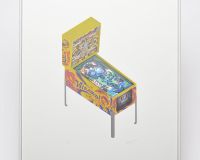Posted on Fri 22 Jul 2016
Prototyping with conductive paint
Inspiration from board games, getting connected with conductive ink and the first play test

Posted by

Jono Sandilands
Jono Sandilands is a graphic artist exploring design, printmaking and screen-based-technology, embedding interaction and games into physical artworks.Project

Playable Prints: Watershed New Talent Residency 2016
Physical printed artworks with embedded interactivity and games.My gameplan has been to quickly test out ideas for different subject matters (games), to answer a few questions. How will digital embed (seamlessly) into the print? and will it be as successful as the previous pinball prints? My thinking has been that the pinball machines lent themselves quite well to the execution of embedding a digital screen into the print, but this might not work so well for other concepts.
Board Games
On a project I like to latch onto an idea to tease out inspiration and to really get to grips with a subject.
Many of these starting points come from childhood memories and over the last few weeks (between getting swallowed up by the impending doom of print deadlines in my part-time design job) I've been excavating memories of board games from my childhood, particularly games from my grandparents house.
[embed]<script async defer src="//assets.pinterest.com/js/pinit.js"></script><a data-pin-do="embedBoard" data-pin-board-width="400" data-pin-scale-height="240" data-pin-scale-width="80" href="https://uk.pinterest.com/jonosandilands/retro-board-games/"></a>[/embed]
There's something about the feeling playing board games give us that I would like to incorporate into the aesthetic of Playable Prints.
Conductive Ink
I finally got my hands on some Bare Conductive electric paint and a touchboard this week thanks to David Haylock, Creative Technologist here at Watershed.
[embed]<blockquote class="instagram-media" data-instgrm-captioned data-instgrm-version="7" style=" background:#FFF; border:0; border-radius:3px; box-shadow:0 0 1px 0 rgba(0,0,0,0.5),0 1px 10px 0 rgba(0,0,0,0.15); margin: 1px; max-width:658px; padding:0; width:99.375%; width:-webkit-calc(100% - 2px); width:calc(100% - 2px);"><div style="padding:8px;"> <div style=" background:#F8F8F8; line-height:0; margin-top:40px; padding:50.0% 0; text-align:center; width:100%;"> <div style=" background:url(data:image/png;base64,iVBORw0KGgoAAAANSUhEUgAAACwAAAAsCAMAAAApWqozAAAABGdBTUEAALGPC/xhBQAAAAFzUkdCAK7OHOkAAAAMUExURczMzPf399fX1+bm5mzY9AMAAADiSURBVDjLvZXbEsMgCES5/P8/t9FuRVCRmU73JWlzosgSIIZURCjo/ad+EQJJB4Hv8BFt+IDpQoCx1wjOSBFhh2XssxEIYn3ulI/6MNReE07UIWJEv8UEOWDS88LY97kqyTliJKKtuYBbruAyVh5wOHiXmpi5we58Ek028czwyuQdLKPG1Bkb4NnM+VeAnfHqn1k4+GPT6uGQcvu2h2OVuIf/gWUFyy8OWEpdyZSa3aVCqpVoVvzZZ2VTnn2wU8qzVjDDetO90GSy9mVLqtgYSy231MxrY6I2gGqjrTY0L8fxCxfCBbhWrsYYAAAAAElFTkSuQmCC); display:block; height:44px; margin:0 auto -44px; position:relative; top:-22px; width:44px;"></div></div> <p style=" margin:8px 0 0 0; padding:0 4px;"> <a href="https://www.instagram.com/p/BIIC41CjtC1/" style=" color:#000; font-family:Arial,sans-serif; font-size:14px; font-style:normal; font-weight:normal; line-height:17px; text-decoration:none; word-wrap:break-word;" target="_blank">Playing with some electric paint #bareconductive #playableprints</a></p> <p style=" color:#c9c8cd; font-family:Arial,sans-serif; font-size:14px; line-height:17px; margin-bottom:0; margin-top:8px; overflow:hidden; padding:8px 0 7px; text-align:center; text-overflow:ellipsis; white-space:nowrap;">A photo posted by Jono Sandilands (@jonosandilands) on <time style=" font-family:Arial,sans-serif; font-size:14px; line-height:17px;" datetime="2016-07-21T13:46:33+00:00">Jul 21, 2016 at 6:46am PDT</time></p></div></blockquote>
<script async defer src="//platform.instagram.com/en_US/embeds.js"></script>[/embed]
Conceptually the idea of conductive ink is great and it's overdue I play with it in my work. In theory I thought I could jump into using it quite easily, however I've had a bit of a learning curve working with the new material and its little quirks.
I made a stencil to paint through so I could 'print' a few versions testing different dilutions of the quite thick and tacky paint. According to the official tutorial on dilution you should be keeping a few things in mind, mainly the obvious fact it will decrease the conductivity of the paint.
Being used to working in solitude and referring to the internet for advice it's great now to be based at PM Studio where I'm surrounded by knowledgeable people! Tom Metcalfe gave me some quick pointers in dilution based on the screenprinted invite and the workshop they did through research at Dundee University in 2011/12.
I started to encounter a few problems connecting the touchboard. Although I was getting a connection according to the multimeter, I was not able to touch the ink like a button as intended. After some problem solving with David, we worked out it was a case of altering the sensitivity of the board (it was picking up signal from my hands when in close proximity of the ink, sending it all out of whack).

The next issue was how I connect the board to the ink. I was getting inconsistent results, especially when moving the print around. I made a quick prototype attachment for the bulldog clip (which has a double use of displaying the print and making the connection between print and board). The attachment consists of some stripped wire glued to a piece of card, connecting the paint to board, eradicating the slightly loose connection.
There are some mixed reviews about Bare Conductive and I can see why from these sorts of tribulations, one could start to look at other options. But like anything once you get a system, you're rolling.
I'll be testing out screenprinting with the ink this weekend. I hope that the results will be much neater than my hastily stencilled attempts.
Amazing!
I've been continuing work in learning Unity to finish up the maze game. The idea is the maze generates a new path so it is never the same twice. With the maze, it seems natural to keep on a steel ball (pinballl) theme.

Having this game in development gives me some great content for testing out a proof of concept with playable prints and this weeks foray with conductive ink.
Play test
Small steps, proof of concept with conductive ink and a projector (video below)
[embed]<blockquote class="instagram-media" data-instgrm-captioned data-instgrm-version="7" style=" background:#FFF; border:0; border-radius:3px; box-shadow:0 0 1px 0 rgba(0,0,0,0.5),0 1px 10px 0 rgba(0,0,0,0.15); margin: 1px; max-width:658px; padding:0; width:99.375%; width:-webkit-calc(100% - 2px); width:calc(100% - 2px);"><div style="padding:8px;"> <div style=" background:#F8F8F8; line-height:0; margin-top:40px; padding:50.0% 0; text-align:center; width:100%;"> <div style=" background:url(data:image/png;base64,iVBORw0KGgoAAAANSUhEUgAAACwAAAAsCAMAAAApWqozAAAABGdBTUEAALGPC/xhBQAAAAFzUkdCAK7OHOkAAAAMUExURczMzPf399fX1+bm5mzY9AMAAADiSURBVDjLvZXbEsMgCES5/P8/t9FuRVCRmU73JWlzosgSIIZURCjo/ad+EQJJB4Hv8BFt+IDpQoCx1wjOSBFhh2XssxEIYn3ulI/6MNReE07UIWJEv8UEOWDS88LY97kqyTliJKKtuYBbruAyVh5wOHiXmpi5we58Ek028czwyuQdLKPG1Bkb4NnM+VeAnfHqn1k4+GPT6uGQcvu2h2OVuIf/gWUFyy8OWEpdyZSa3aVCqpVoVvzZZ2VTnn2wU8qzVjDDetO90GSy9mVLqtgYSy231MxrY6I2gGqjrTY0L8fxCxfCBbhWrsYYAAAAAElFTkSuQmCC); display:block; height:44px; margin:0 auto -44px; position:relative; top:-22px; width:44px;"></div></div> <p style=" margin:8px 0 0 0; padding:0 4px;"> <a href="https://www.instagram.com/p/BIK3KfjhKNB/" style=" color:#000; font-family:Arial,sans-serif; font-size:14px; font-style:normal; font-weight:normal; line-height:17px; text-decoration:none; word-wrap:break-word;" target="_blank">Amazing gameplay action with conductive ink controller #playableprints</a></p> <p style=" color:#c9c8cd; font-family:Arial,sans-serif; font-size:14px; line-height:17px; margin-bottom:0; margin-top:8px; overflow:hidden; padding:8px 0 7px; text-align:center; text-overflow:ellipsis; white-space:nowrap;">A video posted by Jono Sandilands (@jonosandilands) on <time style=" font-family:Arial,sans-serif; font-size:14px; line-height:17px;" datetime="2016-07-22T16:01:50+00:00">Jul 22, 2016 at 9:01am PDT</time></p></div></blockquote>
<script async defer src="//platform.instagram.com/en_US/embeds.js"></script>[/embed]
I asked a few people to try it out, which helps with guiding what I do next. The physics of the ball are a bit off, and the orientation (having the print vertical) doesn't work for this game as you expect the ball to fall to the ground. However the conductive ink and touchboard hold up to the first play test, will be looking into doing more with the ink especially developing a better system to integrate the circuit into the art work.
[embed]<blockquote class="instagram-media" data-instgrm-captioned data-instgrm-version="7" style=" background:#FFF; border:0; border-radius:3px; box-shadow:0 0 1px 0 rgba(0,0,0,0.5),0 1px 10px 0 rgba(0,0,0,0.15); margin: 1px; max-width:658px; padding:0; width:99.375%; width:-webkit-calc(100% - 2px); width:calc(100% - 2px);"><div style="padding:8px;"> <div style=" background:#F8F8F8; line-height:0; margin-top:40px; padding:50.0% 0; text-align:center; width:100%;"> <div style=" background:url(data:image/png;base64,iVBORw0KGgoAAAANSUhEUgAAACwAAAAsCAMAAAApWqozAAAABGdBTUEAALGPC/xhBQAAAAFzUkdCAK7OHOkAAAAMUExURczMzPf399fX1+bm5mzY9AMAAADiSURBVDjLvZXbEsMgCES5/P8/t9FuRVCRmU73JWlzosgSIIZURCjo/ad+EQJJB4Hv8BFt+IDpQoCx1wjOSBFhh2XssxEIYn3ulI/6MNReE07UIWJEv8UEOWDS88LY97kqyTliJKKtuYBbruAyVh5wOHiXmpi5we58Ek028czwyuQdLKPG1Bkb4NnM+VeAnfHqn1k4+GPT6uGQcvu2h2OVuIf/gWUFyy8OWEpdyZSa3aVCqpVoVvzZZ2VTnn2wU8qzVjDDetO90GSy9mVLqtgYSy231MxrY6I2gGqjrTY0L8fxCxfCBbhWrsYYAAAAAElFTkSuQmCC); display:block; height:44px; margin:0 auto -44px; position:relative; top:-22px; width:44px;"></div></div> <p style=" margin:8px 0 0 0; padding:0 4px;"> <a href="https://www.instagram.com/p/BIK22L4h9h8/" style=" color:#000; font-family:Arial,sans-serif; font-size:14px; font-style:normal; font-weight:normal; line-height:17px; text-decoration:none; word-wrap:break-word;" target="_blank">Prototype game testing with conductive ink controller and projection #playableprints</a></p> <p style=" color:#c9c8cd; font-family:Arial,sans-serif; font-size:14px; line-height:17px; margin-bottom:0; margin-top:8px; overflow:hidden; padding:8px 0 7px; text-align:center; text-overflow:ellipsis; white-space:nowrap;">A photo posted by Jono Sandilands (@jonosandilands) on <time style=" font-family:Arial,sans-serif; font-size:14px; line-height:17px;" datetime="2016-07-22T15:59:04+00:00">Jul 22, 2016 at 8:59am PDT</time></p></div></blockquote>
<script async defer src="//platform.instagram.com/en_US/embeds.js"></script>[/embed]